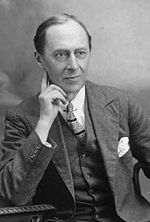Frederick Bligh Bond
| Frederick Bligh Bond | |
|---|---|

Frederick Bligh Bond in 1921
|
|
| Born | 30 June 1864 Marlborough, Wiltshire, England |
| Died |
8 March 1945 (aged 80) Dolgellau, Merionethshire, Wales |
| Occupation | Architect and psychical researcher |
| Employer | Church of England, American Society for Psychical Research |
Frederick Bligh Bond (30 June 1864 – 8 March 1945), generally known by his second given name Bligh, was an English architect, illustrator, archaeologist and psychical researcher.
Bligh Bond was the son of the Rev. Frederick Hookey Bond. He was born in the Wiltshire town of Marlborough. His family was related to William Bligh, through his nephew Francis Godolphin Bond, Bligh Bond's grandfather. He was also a cousin of Sabine Baring-Gould. He was educated at home by his father, who was headmaster of the Marlborough Royal Free Grammar School.
He practised as an architect in Bristol from 1888. His work includes schools, such as the board schools in Barton Hill, Easton, and Southville, Greenbank Elementary School and St George's School. He designed the schools of medicine and engineering at Bristol University and the Music School of Clifton College. He also undertook a number of domestic commissions for the King's Weston estate of Philip Napier Miles, including a number of substantial houses in Shirehampton, the Miles Arms public house in Avonmouth, the now-demolished King's Weston estate office and the public hall in Shirehampton.Cossham Memorial Hospital is also an example of his work. The style of his mature works in the Edwardian years might be described as English Baroque or Queen Anne Revival. In addition he oversaw the restoration of a number of churches, became an acknowledged authority on the history of church architecture, and in 1909 published, with Dom Bede Camm, a two-volume treatise entitled Roodscreens and Roodlofts.
...
Wikipedia
